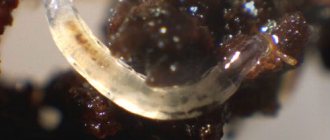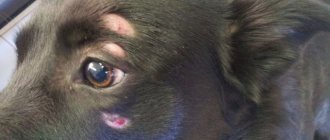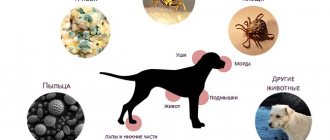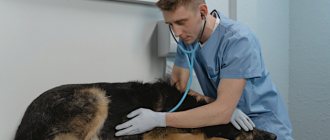Abscesses and abscesses can form in both an old dog and a young and strong dog. Most often, they are caused by various types of injuries, cuts, bites, when the infection penetrates from the outside. Sometimes inflammation occurs inside the body, in a sebaceous gland or other formation.
Such suppurations open on their own or are cleaned by a veterinarian. They heal without problems, but in rare cases the doctor says that because of them a fistula has formed in the dog. In this case, a completely different treatment is required than for an abscess. In this case, you need to act quickly, otherwise the dog will suffer greatly.
It is much worse if this formation connects the body cavities with its surface, which can lead to severe infection, sepsis and death of the dog.
What causes it to form
The word "fistula" comes from the verb "to whistle".
It means emptiness, a defective hole. Another name for fistula. A fistula is an opening through which pus comes out. Outwardly it resembles an abscess, but is more dangerous. The fistula acts as a channel from the inflamed area to the surface of the skin. Through it, the component of the abscess comes out. The fistula wound is tube-shaped, with smooth walls, and formed.
Unlike an abscess, a fistula heals more slowly. The open wound constantly leaks pus. Clearing the cavity of pus does not help healing. A fistula is dangerous because pathogenic microbes can enter the body through it. This will further worsen the dog's condition.
Take the Attention Test! Find 10 differences! (click right here!)
Find the answer Are you bothered by some problem or question? Enter “Breed” or “Name of the problem” into the form, press Enter and you will find out everything about the issue that interests you.
Fistulas are of origin:
- Congenital;
- Purchased.
Congenital fistulas are rare. They are formed due to improper intrauterine formation of the fetus. The wound can connect organs to the body surface. The case requires surgical experience. Without surgery, the puppy will die.
Acquired fistulas are common. They arise due to injuries, cuts, bites, rectal problems, and infectious complications.
By type:
- External;
- Internal.
The pus is drained out through the external openings. Timely treatment can eliminate the problem.
Internal purulent openings are more dangerous. They allow bacteria access to internal organs. Wounds take longer and are more difficult to heal.
Fistulas occur:
- Near the anus;
- On the paw;
- On the stomach;
- On the head.
Near the anus, a fistula occurs if the paraanal gland becomes inflamed. The pain may radiate into the anus. In this place the pet feels severe pain. Pathology worsens the animal's health and behavior. Perianal fistula occurs due to poor nutrition, impaired metabolism, genetic predisposition, and lack of hygiene. Characteristic of some breeds - setters and shepherds. The resulting pathology should not be confused with hemorrhoids or other rectal disease.
Purulent channels can form on the paws. The cause may be a cut, bite, or bone damage. An abscess usually occurs due to a cut. The infection does not allow the abscess to heal - a fistula forms.
A fistula in the abdomen may extend to the abdominal organs. A purulent canal on the abdomen is dangerous. The cause of inflammation is a formation on the mammary gland or skin.
Often purulent canals appear on the animal’s cheeks. This happens due to oral diseases. Inflammation appears on the cheek.
It happens that fistulas are formed due to contact with Ustyug grass. A thorny plant that can pierce the skin and seriously injure. While walking, grass can get into the animal's eyes, nose, ears, groin or belly area, and injure its paws. The seed of the plant enters the muscle and moves along it, causing fistulous formations.
A prerequisite for the appearance of a fistula may be medical intervention. For example, a surgical operation has been performed. Often the formation of fistulas is caused by errors in the sterilization of medical instruments and threads for suturing. Postoperative fistula requires urgent treatment. Otherwise, septic damage is possible.
The fistula cannot be eliminated on its own. Professional treatment required.
Causes
Ligature fistulas can form for the following reasons:
- Violation of aseptic rules during surgery.
- Use of non-absorbable suture material (for example, silk ligatures).
- The use of threads that are too thick and dense, inappropriate for the size of the animal.
- Concomitant diseases that interfere with the healing process (diabetes mellitus).
The reasons for the development of perianal fistula are unbalanced feeding, inactive lifestyle, and genetic predisposition.
How it manifests itself
The disease is easy to recognize. The fistula canal has the shape of a tube with smooth edges. Connective tissue forms smooth walls. The wound is small in diameter. Pus is oozing from it. Hair begins to fall out around the wound.
An abscess or abscess is usually accompanied by high fever, chills, and swelling of the painful area. A fistula may not cause such symptoms.
A crust forms on the fistula canal. Purulent fluid continues to come out from under it. The wound will not heal on its own. Sometimes it heals for a while, then opens again.
Secondary infection may cause rough or weepy patches on the skin. Around, the skin turns red and swells. Festering wounds appear.
Internal fistulas are more difficult to identify. Pus can be released into the digestive tract or into any other physiological cavity. An intestinal fistula releases pus or blood into the stool. An abdominal internal fistula causes widespread infection. The animal becomes depressed, the temperature rises, and pain syndromes become more frequent. Pathology is detected by probing and x-rays.
Symptoms of the disease
You can diagnose a fistula yourself. It has a characteristic smooth surface of the hole; visually it resembles a dense tube. If for an abscess the clinical signs are reduced to increased body temperature, decreased appetite, thirst and swelling of the inflamed area, then with a fistula such symptoms may not appear at all. The maximum that the owner can notice is that a purulent exudate with an unpleasant odor emerges from the open hole. The temperature around the wound does not increase and no swelling is observed.
Hair falls out at the site of the lesion, and if the fistula is complicated by a secondary infection, then the skin around the hole begins to peel off and get wet. It turns red and small ulcers appear on it. The exit hole itself is permanently covered with pus, sometimes it dries out, forming a crust. But discharge still flows from under it. It is important to know that a fistula cannot heal, and if it does heal, it will be for a short time. The liquid accumulated inside will find a way out, and it will inevitably break through.
How to fight
If the cause of the pathology is not eliminated, it will arise again. The reopening will take place at the same or new location. It will be more difficult to eliminate. Only a veterinarian can cure a fistula. Do not try to heal the wound yourself.
After the examination, the attending physician will find out the cause of the pathology.
If the fistulous wound is formed due to tartar, the tooth must be treated or removed. Afterwards the purulent canal is eliminated.
This problem is associated with blockage of the paraanal gland and the appearance of formations. Conservative treatment will not help; surgical resection will be required.
Surgery will also be required if there is a long-standing through hole. After resection and cleaning, the wound edges are sutured. The dog is prescribed antibiotics. The treatment course is designed to prevent the inflammatory process from re-developing.
In addition to antibiotics, the veterinarian may prescribe anti-inflammatory drugs, painkillers and antipyretics. The dose of the medicine is calculated by the doctor depending on the dog’s body weight.
Ointments and solutions are prescribed for treatment. It is not advisable to use iodine; it can leave a burn and contribute to further suppuration. Ointments with a greasy consistency are not recommended; they clog the canal and prevent the hole from being cleared of pus.
The wound must be kept sterile. To do this, it is regularly treated with antiseptic agents. Do not allow the dog to lick or scratch the healing area. The pet will have to wear a special plate around its neck, which will not allow the tongue to reach the problem area.
To strengthen the immune system, the dog needs high-quality nutrition. During the healing process, feed your dog light but nutritious food. Provide constant access to clean water for drinking.
https://dog-care.ru/zdorove/bolezni/svisch-vozle-zadnego-prohoda.html
The fistula takes a long time to heal. May become chronic. To prevent the problem from recurring, abscesses must be thoroughly cleaned and treated.
If it is not possible to contact a veterinarian, and the dog needs help, then try to take the necessary measures. You need to squeeze out the pus. Using a cotton swab soaked in hydrogen peroxide, massage the problem area. Before this, the dog must be restrained and muzzled to prevent it from biting. You can inject the enzyme trypsin into an open wound with a syringe; it will dissolve dead tissue. This procedure is carried out several times a day. You can lubricate the sore spot with levomekol ointment. The use of antibiotics is mandatory. Broad-spectrum drugs are used. Ampicillin, levofloxacin, ceftriaxone are suitable. Injections are given intramuscularly, once a day.
You will eliminate the consequences of the fistula, but not the cause. Without professional treatment, the disease will return again.
What is a fistula and how does it differ from a burst abscess?
Fistulas are channels in the form of a tube communicating with the inflamed area and the surface of the body. Through them, the contents of the abscess flow out. Their holes have a clear shape, the walls are smooth, formed by dense connective tissue, and have the appearance of a tube.
An ordinary abscess opens with jagged, torn edges; after cleaning the cavity, it scars and heals. In the case of the formation of a stable channel, this does not happen. The animal develops a constantly open wound that oozes pus. In addition, pathogens can enter the body through it, which further worsens the dog’s condition.
Such formations can occur near the tail in the anus due to blockage of the paraanal glands. This is a fairly common problem, but if you do not start it, troubles can be avoided.
Sometimes the dog's leg suffers. This is mainly a problem for old dogs with arthrosis and arthritis. The disease causes severe pain, limits mobility and threatens inflammation of bone tissue with dire consequences for health.
Prepare before going to the vet
In the office, you may have to provide the veterinarian with all possible assistance (hold the animal while they take blood for analysis, give an injection, extinguish aggression, calm your voice, scratch its ears, stroke it). If you know that you are terrified of blood, IVs, or definitely cannot withstand the type of medical interventions, then perhaps you should ask a friend or relative for help.
Find a veterinary certificate, veterinary passport.
Take:
- Leash;
- Collar;
- Muzzle;
- Carrying;
- A pack of napkins;
- litter;
- Bowl, water (at the veterinarian's discretion)
Prepare answers to possible questions from the veterinarian:
- Are all vaccinations up to date on the animal?
- Pet’s behavior in recent days, appetite;
- His diet;
- What drugs and medicines did you give to the animal;
- Latest test data (if available).
It’s better to make an appointment in advance - you’ll save time and be able to calculate when you’ll have to take time off. This does not apply to life-threatening situations where you will have to take an animal to a veterinary clinic without an appointment.
Be affectionate with your pet, play, talk to him. You can take his favorite toy with you so that while you wait for your turn at the reception, you can distract your friend from the new environment.
Furry, feathered or scaly ones also need to be prepared. No matter how much you want to treat your little one with something tasty, remember: you need an empty stomach. Feeding is prohibited!
You can wash your animal without using detergents. But it is important not to touch your pet if there is nasal discharge, watery eyes, salivation (salivation), dandruff, scratching, rashes, skin scabs, loss of hair/feathers/scales, wounds and other external manifestations of a potential disease.
If the veterinarian has instructed, collect the animal’s urine in a sterile container, and pick up the feces with a stick (no blades of grass, specks, or debris). Transfer the feces into a sterile container. Send to the biochemical laboratory within 6 hours. The feces are examined for eggs of roundworms, pinworms, tapeworms, liver flukes, echinoccus, alvecoccus, pork tapeworm, bovine tapeworm, and gastrointestinal bleeding is detected.
At the veterinary hospital, the animal’s blood will be analyzed for antibodies to allergens, viruses, bacteria, and parasites.
Clinical signs
Some breeds are predisposed to developing anal furunculosis. First of all, German shepherds and Irish setters are at risk. This disease also occurred in collies, retrievers, English bulldogs, spaniels, and mixed breeds. Males get sick twice as often as females. The average age of an animal is about 5 years, but cases of fistulas have occurred at any other age.
The first signs of the disease are licking in the anal area, false urge to defecate, unpleasant odor, constipation or, on the contrary, diarrhea, ulcers, pus in the perianal area. The animal experiences severe discomfort.
Choosing a veterinary clinic
We determine the veterinary clinic where you plan to go. A big PR company doesn't promise quality. The price is explained by the huge amount of money invested in advertising and “signboarding” of the establishment.
It’s great if you can ask your friends about clinics where their pets were treated “humanely.” If you travel far from them, it may be worth sacrificing time for the health of your pet.
A few more tips on how to spot an unverified veterinary clinic:
- Refusal to provide certificates and licenses for veterinary activities.
- Strange and suspicious behavior of the veterinarian (inconsistency, flattery, attempts to intimidate, shouting).
- Prices are too low (compared to other organizations).
- Refusal to freely visit the veterinary clinic.
“We have a sanitary day”
Beware of scammers!
When you contact the veterinary clinic, you are informed: “we cannot accept you at this address, sanitary day/repair/inspection.” How much intelligence does a dispatcher have? The client is persuaded to have a veterinarian come to his home. The price does not change.
A veterinary clinic can exist purely nominally. And the invited “Aibolit” will not bear responsibility. There is a high probability of running into a person without a veterinary diploma or simply an unprofessional.
It is better to find time to visit the veterinary clinic on your own. This is safer for the animal.
Prevention of occurrence
- Carrying out planned operations with highly qualified specialists in veterinary clinics with a good reputation.
- Compliance with all veterinarian recommendations in the postoperative period (use of antibiotic therapy as scheduled, treatment of sutures, wearing a protective blanket or collar).
- Examination of the pet after walks in the summer-autumn period (especially the area of the paws, face, ears).
- Dogs prone to inflammation of the anal glands should be cleaned every 3-4 months, or as soon as the first symptoms appear (rolling on the butt).
Fistulas in dogs can be located in different areas, but treatment comes down to one thing - eliminating the source of inflammation. The postoperative type is one of the most labor-intensive in terms of therapy, as it often requires repeated surgery. Taking measures on your own is not recommended due to the risk of developing more serious complications.
Games on feelings
In real veterinary clinics there will be elements of “divorce”.
Veterinarians say that this is often determined by the client’s wallet. The greater the opportunity to pay for services and the more the owner worries about his pet, the more likely the animal will be prescribed additional immunostimulants, dietary supplements, water-soluble and fat-soluble vitamins, and special food. There are cases when this is really necessary (pedigreed, show animals, weakened after a serious illness). But it will be good if you ask your veterinarian in detail about the need for each appointment. Find out in detail about the results of the examination and analysis of your pet’s condition. Be persistent. Do not give in to attempts to intimidate you, be consistent in your questions. Consult a specialist who does not work at this veterinary clinic. If it turns out that half of the prescriptions are prescribed to enrich the veterinarian’s pocket, and not for the health of the animal, feel free to leave. And do not forget to leave a negative review about the organization - other owners may also suffer.
Clinical case of surgical treatment of chronic fistulas of the perianal region in a shepherd dog.
Day MJ, Weaver BMQ Pathology of surgically resected tissue of 305 cases of anal furunculosis in the dog. Journal of the Small Animal Practitioner. 1992 33, 583-589.
2. Dudsberg SC, Spurgeon TL, Liggitt HD Anatomic predisposition to perianal fistulae formation in the German Shepherd Dog. American Journal of Veterinary Research 1985 46, 1468-1472.
3. Harkin KR, Walshaw R., Mullaney TP Association of perianal fistulas in dogs. Journal of the American Animal Hospital Association 1987 23, 95-100.
4. Harkin KR, Walshaw R., Mullaney TP Association of perianal fistula and colitis in the German shepherd dog: response to high-dose prednisone and dietary therapy. J Am Anim Hosp Assoc. 1996 32(6), 515–520.
5. Killingsworth, CR, Walshlaw, R., Dunstan, RW et al. Bacterial population and histologic changes in dogs with perianal fistula. American Journal of Veterinary Research 1988 49, 1736-1741.
6. Misseghers BS, Binnington AG, Mathews KA Clinical observations of the treatment of canine perianal fistulas with topical tacrolimus in 10 dogs. Can Vet J 2000 41, 623-627.
7. Patricelli AJ, Hardie RJ, McAnulty JF Cyclosporine and ketoconazole for the treatment of perianal fistulas in dogs. Journal of the American Veterinary Medical Association 2002 220, 1009-1016.
Author: Vorontsov A.A., Mordas E.M., Guzeeva E.V. (12.2007)
In some cases, dogs may develop inflammation of the anal glands. They are located near the anus and have the characteristic appearance of “bags” located under the skin. Without regular cleaning, the gland ducts often become clogged, a large amount of secretion accumulates in the cavity and inflammatory reactions develop.
How to find out the truth
Another possible way for veterinarians to make dishonest money is to conceal the diagnosis. Let's say a veterinarian discovers a malignant tumor in a cat. But if he says that the tumor is benign and treatable. A housewife who dotes on her pet will give money for already useless procedures, medications and surgical interventions.
The veterinarian may deliberately “downplay” the diagnosis in order to earn more money. If something doesn't add up, insist on clarification. There is no need to be intimidated by unfamiliar terms - take a short break and try to find information on the Internet.
You are free to leave (or threaten to do so) to another clinic at any time.
Make sure that the veterinary clinic is honest - get tested in an independent laboratory.
Justice
What to do if an animal was injured as a result of unprofessional actions of a veterinarian:
- Write an official complaint addressed to the head of the clinic.
- File a complaint with the city veterinary department.
- You can contact Rospotrebnadzor.
- Contact a lawyer for help
The Law “On the Protection of Consumer Rights” and Article 245 of the Criminal Code “Cruelty to Animals” are the grounds for considering claims regarding the work of veterinary clinics.
Fistula in a dog after surgery
Ligature fistula appears after surgery. Its formation can be caused by incorrect actions of the surgeon. According to statistics, it most often appears after sterilization. The reason is insufficient quality of treatment or infection. If you do not immediately notice the problem, then purulent exudate will accumulate in the cavities of the body. The owner should carefully inspect the wound. If tubercles appear at the site of the sutures, upon palpation of which the animal feels severe pain, then literally in 3-4 days a hole may open. The accumulated pus will come out through it.
If a dog develops fistulas after surgery, this indicates the surgeon’s unprofessionalism. It is advisable to inquire about the doctor’s reputation before going to the clinic. After all, a seemingly simple operation can cause the development of a serious pathology. And it is much more difficult to treat her.
Saving
What to do if funds are limited and your pet needs medical care:
- Some procedures can be carried out independently. Giving a drug injection to a cat or dog is not difficult. Dressing uncomplicated wounds is also sufficient. Ask your veterinarian to teach you.
- How to properly give a pill to an animal: hide it in a lump of tightly rolled minced meat. If the animal bites through the decoy, you can crush the tablet and dissolve it in water, milk, liquid porridge, or food.
- If an animal has been prescribed a course of vitamins or some other non-medicinal but expensive drugs, it may be worth finding analogues at a lower price.
- There are various benefit programs in which you can participate. This could be, for example, sterilization, castration, or vaccination of an animal.
Methods of treatment and emergency assistance
The main point in the treatment of a fistula is to eliminate the cause that caused and maintains suppuration. It is necessary to ensure rapid release of the abscess and canal from pus and prevent its further formation. The easiest way would be to rinse with an antiseptic solution, but this does not always bring the desired effect.
The canal may be curved, contain pockets and additional cavities in which pus accumulates. It is difficult to remove exudate from such areas, so it is necessary to resort to surgical intervention - the canal is dissected along its entire length so that there are no obstacles to the outflow of pus. The abscess cavity is examined for the presence of pockets, which are dissected after detection. The wound is thoroughly washed with antiseptics, sulfonamide drugs and antibiotics are placed in it.
Antiseptic ointments and other means that clog the canal should not be used for treatment; this will prevent the drainage of exudate and lead to complications of the disease.
It is important to preserve the channel for the first time so that pus and other contents can freely drain from the wound. Sutures can only be placed on aseptic wound surfaces. If there remains a possibility of developing a purulent process, then a sutured wound will lead to a recurrent abscess. When the purulent focus is eliminated and all pathological tissues are removed, it is necessary to freshen the wound - the granulation and epithelial tissue is dissected and sutures are applied. Otherwise, the edges will not grow together.
Surgery is the only effective method of therapy. In this case, only after complete excision of the fistula tract and pathological cavity is recovery possible. Modern methods using electrocoagulation and freezing with liquid nitrogen do not show adequate effectiveness. But during the operation you need to be careful not to damage the surrounding tissue. Thus, when treating a fistula of the paraanal glands, injuries to the anal sphincter and rectum often occur.
Antiseptics:
- potassium permanganate solution 0.05%;
- furatsilin solution 0.02%;
- hydrogen peroxide 3%;
- migstream;
- ethacridine lactate.
Additional therapy includes a general course of antibiotics - bicilin, tetracycline. Local novocaine blockade of the affected area has a good effect; penicillin or streptomycin is diluted in novocaine. Intravenous infusions of physiological solutions and glucose should relieve intoxication in the body.
Important points
- Refusal to vaccinate. This is dangerous for the animal and all those who will come into contact with it (people). Vaccination is a scientifically proven method of preventing many infectious diseases. Get your animal vaccinated by a trusted veterinarian (or with his approval yourself). It is important to get vaccinated against rabies - this is a fatal disease induced by the Rabies lyssavirus virus, which cannot be cured, but can be prevented.
- Anesthesia - inhalation, intravenous, anesthesia - epidural, conduction. They are necessary so that the animal does not suffer, to prevent painful shock. The veterinarian’s “hands on” are important here - both overdose and weak anesthesia lead to serious consequences (shock, poisoning, death) for the animal.
- Sterility, antiseptic. If you see that the veterinarian does not follow the rules of antiseptics (reuses disposable syringes, diapers, bandages, does not treat hands with antiseptic after contact with the previous animal), the best choice would be to contact another veterinarian.
- Important medicines:
- Antibiotics - amoxicillin, tilozil, trimethoprim, sulfadiazine, lincomycin, marbofloxacin;
- Antipyretics - paracetamol, salicylic acid preparations, antipyrine, butadione, amidopyrine;
- Anti-inflammatory drugs - vedaprofen, choline salicylate cycloferon, aspirin;
- Anesthetics - novocaine, lidocaine, dicaine, trimecaine;
- Hemostatics - fibrinogen, thrombin, vikasol, phytomenadione, calcium chloride, etamsylate;
- Antiparasitic - praziquantel, aversectin, albendazole, ivermectin, fluralaner.
If you care what happens to your pet, you should not neglect appointments.
Don't let unverified veterinary clinics endanger your pet and profit from their owner's feelings! If you have time and desire, it is worth trying to achieve justice in case of violation of ethical or legal standards.
Treatment
Many owners panic when they discover a fistula in their dog. How to treat it? Definitely go to the clinic. It is not recommended to take any measures on your own. This will not only not help the animal, but may even harm it. The doctor makes a decision only after examination. If necessary, he will order an examination. The main thing is to find out the reason that provoked this pathology. For example, if a fistula occurs under the eye, then the dog’s jaw is examined. Sometimes it can be triggered by tartar, so it will be necessary to remove it.
The most effective treatment for a fistula in a dog is surgery. How does it happen? The surgeon removes the fistula, thoroughly rinses the cavity and sutures the incision. To avoid infection, the dog will be prescribed antibiotics. Conservative therapy brings only temporary relief. After it, relapses often occur.











